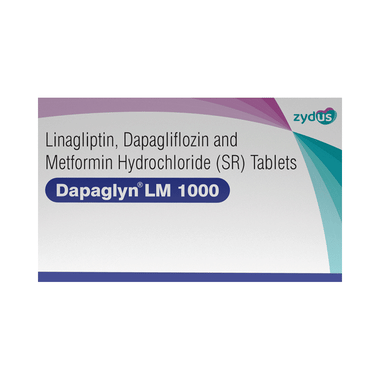Linaxa DM 1000 Tablet SR
 Prescription Required
Prescription Required

Product introduction
Take Linaxa DM 1000 Tablet SR exactly as prescribed by your doctor. It may be taken with or without food, once or twice daily. For maximum benefits, take it at the same time each day to maintain consistent blood sugar control. Monitor your blood sugar levels regularly and follow any dietary and lifestyle recommendations from your doctor.
Common side effects may include nausea, diarrhea, vomiting, abdominal pain, loss of appetite, and weakness. These effects are generally mild and can be managed by taking the medication with food. If you experience persistent or severe side effects, such as signs of low blood sugar (e.g., dizziness, confusion) or symptoms of urinary tract infections, contact your doctor.
Avoid using Linaxa DM 1000 Tablet SR if you have severe kidney or liver problems, or if you are allergic to any of its components. Inform your doctor if you have a history of pancreatitis, urinary tract infections, or diabetic ketoacidosis. Maintain adequate fluid intake, especially if you have symptoms of dehydration or if you are taking other medications that may affect your kidney function.
Uses of Linaxa DM Tablet SR
Benefits of Linaxa DM Tablet SR
In Treatment of Type 2 diabetes mellitus
Side effects of Linaxa DM Tablet SR
Common side effects of Linaxa DM
- Nausea
- Vomiting
- Diarrhea
- Stomach pain
- Loss of appetite
- Weakness
- Flatulence
- Nasopharyngitis (inflammation of the throat and nasal passages)
- Urinary tract infection
How to use Linaxa DM Tablet SR
How Linaxa DM Tablet SR works
Safety advice
What if you forget to take Linaxa DM Tablet SR?
All substitutes
Quick tips
- Take the medicine at the same time each day to maintain stable blood sugar levels and enhance effectiveness.
- Check your blood sugar levels regularly to ensure the medication is working effectively.
- Drink plenty of water throughout the day to prevent dehydration and support kidney function.
- Be aware of common side effects like nausea and diarrhea. If these persist or worsen, consult your doctor.
- Learn to recognize and manage symptoms of low blood sugar, such as dizziness or confusion. Keep a source of fast-acting carbohydrates, like glucose tablets, handy.
- Incorporate regular physical activity and a balanced diet into your routine to complement the effects of the medication and support overall diabetes management.
Fact Box
Patient concerns
FAQs
What is Linaxa DM 1000 Tablet SR used for?
How should I take Linaxa DM 1000 Tablet SR?
Can I take this medication if I have kidney or liver problems?
How should I monitor my condition while on this medication?
Can I take other medications while using this treatment?
What precautions should I take while on this medication?
Disclaimer:
Tata 1mg's sole intention is to ensure that its consumers get information that is expert-reviewed, accurate and trustworthy. However, the information contained herein should NOT be used as a substitute for the advice of a qualified physician. The information provided here is for informational purposes only. This may not cover everything about particular health conditions, lab tests, medicines, all possible side effects, drug interactions, warnings, alerts, etc. Please consult your doctor and discuss all your queries related to any disease or medicine. We intend to support, not replace, the doctor-patient relationship.References
Marketer details
Lab tests offered by us







